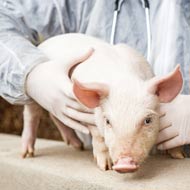
Novel tools could be applied to the study of many diseases
Scientists have developed new tools to study a vital aspect of the pig immune system, which could improve vaccines and shed light on a number of diseases.
A team of UK researchers used the novel method to examine the response of immune cells, called CD8 (‘killer’) T cells, against flu infection or vaccination in pigs.
T cells offer protection against multiple strains of flu but current vaccines are unable to activate them effectively. The latest study, published in PLOS Pathogens, allowed scientists to examine pigs’ T cell responses to influenza for the first time.
Findings suggest that aerosol delivery of a vaccine is highly efficient in triggering T cell responses in the lung. This localised response is essential for protecting against respiratory diseases.
Scientists say the tools can also be used to identify virus proteins that are recognised by the immune system, which would help to design more effective vaccines. The same method could be applied to other significant pig diseases, such as foot-and-mouth-disease and African swine fever.
Dr Elma Tchilian of the Pirbright Institute commented: “This study will equip us to track T cells during infection and understand how best to vaccinate animals and humans to achieve powerful protective immune responses.
"Our tools fill a gap which previously hindered swine immunology research, and can now be used in the study of many diseases.”
Lead author Professor Andrew Sewell said pigs offer a very good model system for influenza virus infection.
He added: “They can be infected with both human and bird flu in addition to swine flu and are known to act as important ‘mixing vessels’ for the creation of pandemic flu strains.”



 The RCVS has announced a new version of its 1CPD mobile app, with enhanced features for veterinary surgeons and veterinary nurses to record their continuing professional development.
The RCVS has announced a new version of its 1CPD mobile app, with enhanced features for veterinary surgeons and veterinary nurses to record their continuing professional development.